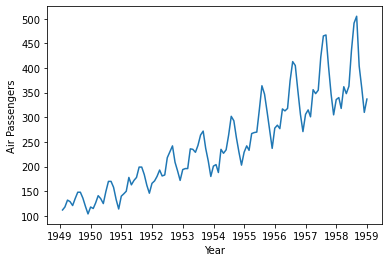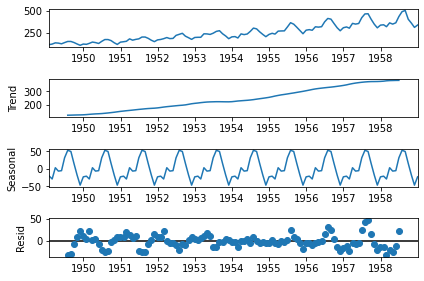Last Update: June 20, 2022
Time Series Decomposition: Classical Method in Python can be done using statsmodels package seasonal_decompose function found within its statsmodels.tsa.api module for estimating time series trend-cycle, seasonal and remainder components. Main parameters within seasonal_decompose function are x with time series data, model with seasonal component type and two_sided with moving average method used in filtering.
As example, we can do training range univariate time series classical additive seasonal decomposition by moving averages using data included within datasets R package AirPassengers object [1].
First, we import packages pandas for data frames, statsmodels for data downloading and time series decomposition and matplotlib for training range and time series decomposition charts [2].
In [1]:
import pandas as pd
import statsmodels.api as sm
import statsmodels.tsa.api as ts
import matplotlib.pyplot as plt
Second, we create mdata model data object using get_rdataset function, convert mdata object into a data frame using DataFrame function and display first five months of data using print function and head data frame method to view time series structure.
In [2]:
mdata = sm.datasets.get_rdataset(dataname="AirPassengers",
package="datasets",
cache=True).data
mdata = pd.DataFrame(data=mdata["value"]).set_index(
pd.date_range(start="1949", end="1961", freq="M"))
print(mdata.head())
Out [2]:
value
1949-01-31 112
1949-02-28 118
1949-03-31 132
1949-04-30 129
1949-05-31 121
Third, we delimit training range for model fitting as first ten years of data and store outcome within tdata object. Then, we delimit testing range for model forecasting as last two years of data and store outcome within fdata object. Notice that training and testing ranges delimiting was only included as an educational example which can be modified according to your needs.
In [3]:
tdata = mdata[:"1958-12-31"]
fdata = mdata["1959-01-01":]
Fourth, we view training range data with plot, ylabel and xlabel functions. Within plot function, training range data object is included. Within ylabel and xlabel functions, vertical axis label and horizontal axis label strings are included.
In [4]:
plt.plot(tdata)
plt.ylabel("Air Passengers")
plt.xlabel("Year")
plt.show()
Out [4]:
Figure 1. Training range data.Fifth, we do training range time series classical additive seasonal decomposition by moving averages with seasonal_decompose function and store results within tsdec object. Within seasonal_decompose function, parameters x=tdata includes training range data object, model="additive" includes additive seasonal component and two_sided=True includes centered seasonal simple moving average estimation. Notice that we have to evaluate whether time series classical additive or multiplicative seasonal decomposition is needed. Also, notice that seasonal_decompose function parameters were only included as educational examples which can be modified according to your needs. Then we do time series decomposition chart with tsdec object plot method.
In [5]:
tsdec = ts.seasonal_decompose(x=tdata, model="additive",
two_sided=True)
tsdec.plot()
plt.show()
Out [5]:
Figure 2. Training range time series classical additive seasonal decomposition by moving averages.References
[1] Data Description: Monthly international airline passenger numbers in thousands from 1949 to 1960.
Original Source: Box, G. E. P., Jenkins, G. M. and Reinsel, G. C. (1976). “Time Series Analysis, Forecasting and Control”. Third Edition. Holden-Day. Series G.
Source: datasets R Package AirPassengers Object. R Core Team (2021). “R: A language and environment for statistical computing”. R Foundation for Statistical Computing, Vienna, Austria.
[2] pandas Python package: Wes McKinney. (2010). Data Structures for Statistical Computing in Python, Proceedings of the 9th Python in Science Conference, 51-56.
statsmodels Python package: Seabold, Skipper, and Josef Perktold. (2010). “statsmodels: Econometric and statistical modeling with python”. Proceedings of the 9th Python in Science Conference.
matplotlib Python package: John D. Hunter. (2007). Matplotlib: A 2D Graphics Environment. Computing in Science & Engineering, 9, 90-95.